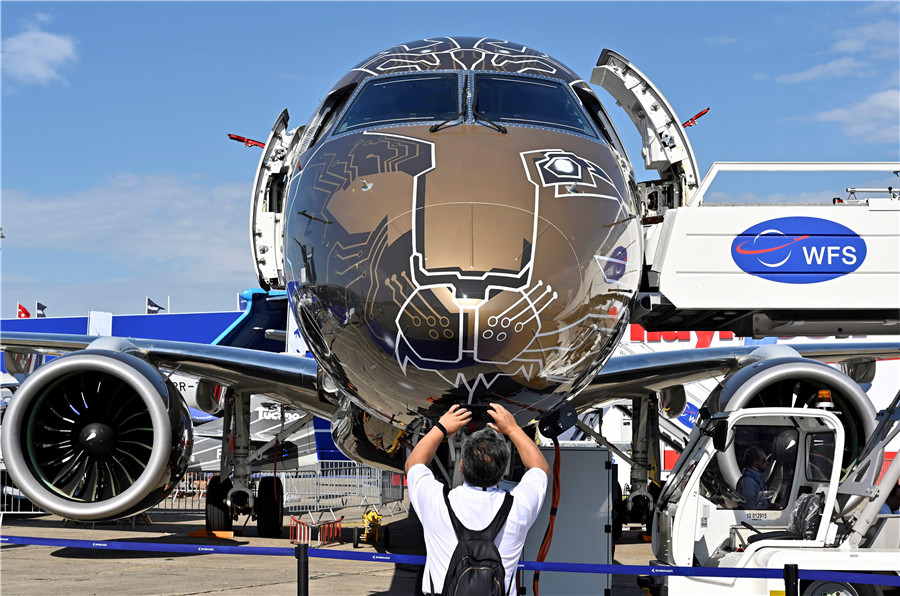Embraer hopes smaller cities can drive its China expansion
By Zhu Wenqian | China Daily | Updated: 2019-12-13 10:10

Brazilian aircraft manufacturer Embraer SA, one of the largest plane makers in the world, is eyeing the fast-developing regional aviation market in China's smaller cities to further drive its growth.
The plane maker, which produces commercial aircraft with fewer than 150 seats, plans to introduce its latest and largest-ever jet, the single-aisle E195-E2, to China, its second-largest market after the United States.
By early next year, the aircraft model is expected to receive certification from the Civil Aviation Administration of China. In April, it received airworthiness certificates from the Brazilian Civil Aviation Agency, the US Federal Aviation Administration and the European Aviation Safety Agency.
Embraer is now in discussions with major domestic carriers, including State-owned and private airlines, about potential purchases of its latest E195-E2 aircraft.
Guo Qing, vice-president of sales and marketing at Embraer China, said Embraer attaches great importance to the China market. The regional aviation market is a short board in China. It will have a significant increment of regional aircraft in the next few years, faster than the United States, and the company is confident in the growth potential.
"Many domestic airlines now use mainline aircraft to operate regional flights, which may cause a waste of resources. With the high capacity of mainline planes, airlines prefer to offer fewer flights, which restrains the development of regional aviation markets," Guo said.
"Right-sized jets allow airlines to offer cheaper flight tickets to small market routes with smaller passenger flows. Carriers will become more profitable compared with using mainline aircraft. Domestic airlines should make use of the rich flying rights and time slot resources on regional routes, and launch more such flights," he said.
In October, the E195-E2 conducted its first commercial flight in Brazil operated by Azul Brazilian Airlines. Embraer said the aircraft model, with fewer seats, is suitable to complete trunk line fleets in slack seasons. It is also good for regional flights that connect second-, third-and fourth-tier cities in China.
Currently, Embraer accounts for more than 70 percent share of the regional aviation market in China. Bombardier Inc from Canada, and China's first homebuilt regional passenger jetliner ARJ21 produced by Commercial Aircraft Corp of China account for the remainder.
Last year, China had 169 regional airports, accounting for 72 percent of the total number of airports nationwide. Yet, the number of regional flights available is small. For instance, Guangzhou-based China Southern Airlines owns 852 aircraft, while the number of planes that fly regional routes account for just 2.58 percent of the total.
By Sept 30, airlines on the Chinese mainland operated 3,583 aircraft, including 189 regional aircraft, which made up for 5.27 percent. Now, there are a total of 10 carriers including Xiamen Airlines, Tianjin Airlines, Chengdu Airlines, China Express, Colorful Guizhou Airlines, and Guangxi Beibu Gulf Airlines that operate regional aircraft, according to aviation industry reports.
In comparison, major US carriers serve 37 percent of US airports and regional airlines reach 93 percent of the airports, according to the Regional Airline Association. Meanwhile in the US, the passenger fleet will maintain modest growth in the long term, according to the FAA.
"Carriers must connect as many small cities as possible to their hub airports to remain competitive. The sustainable growth of regional aviation is the core competitiveness of the Chinese airline industry," said Li Guijin, a professor at the Civil Aviation Management Institute of China in Beijing.
"The central and western areas of China have the largest number of high-altitude airports, and it is an area with rich opportunities to develop regional aviation. There should be more types of aircraft that are suitable to fly in high-altitude regions," he said.
























